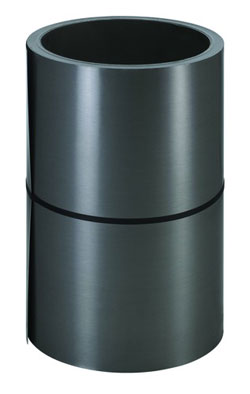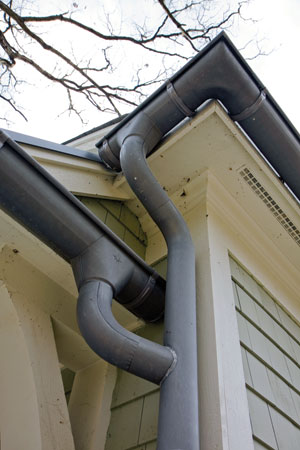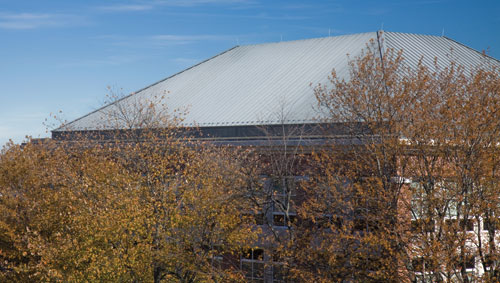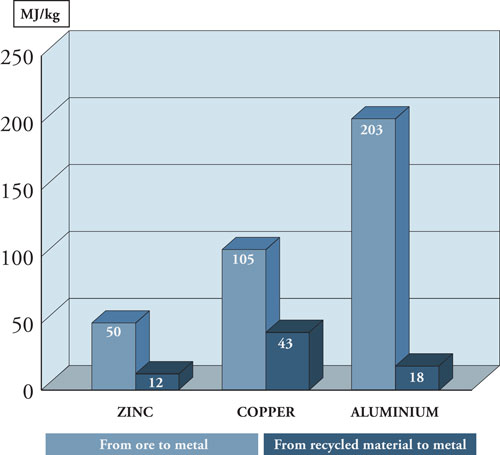Zinc Roofing and Wall Systems
 |
Photo courtesy of VM Zinc Zinc metal is produced into rolls with an initial shiny bright appearance. |
Many manufacturers work with building professionals during the design phase and even during construction to advise on installation, and many strongly recommend or even require training prior to installation. In the process, a misperception that zinc is hard to work with and install is being overcome. One aspect of working with zinc, similar to all architectural metals, is its expansion and contraction. Zinc will move approximately 1 inch in 30 feet so the design must be engineered to accommodate this normal thermal movement. To achieve this, a combination of sliding and fixed clips must be installed in zinc roofing while wall systems use similar measures to achieve the same results. The sliding clips consist of two parts in which one part can slide to accommodate thermal movement. Working temperature is another misunderstood aspect of working with zinc and is particularly important when bending the material on site. The material is malleable but can become cold and brittle at lower temperatures. Therefore, zinc should not be folded when the metal is at temperatures of less than 45 °F. Crazing, which is seen as long wrinkles in the material, can occur if this is attempted. When working in temperatures below 45 °F, installers can use a heat gun to warm the material to the right temperature for bending and installation or fold the material in a temperature-controlled environment before moving to the building site for installation. Pre-manufactured wall panels and flashings also limit the need for bending zinc on the job site. It is important to factor temperature into construction scheduling when planning to bend or fold the material prior to installation. Once the material is installed correctly, however, low temperatures do not create problems provided accommodations have been made for thermal expansion and contraction.
In addition to the strong historical track record of zinc, architects should also be aware that there are some emerging trends and practices of companies that manufacture zinc building products that will make it easier to specify and design zinc into buildings in the U.S. First is the offering of material in 48-inch-wide products instead of only the previously available meter-wide material. This coordination with American standard construction sizes will make it easier to design and install zinc wall and roofing products at new scales and with more economical installation. Second, is a global approach to the fabrication and service for a specific product. This means that a product can be specified in the U.S. for a project in Europe, China or the Middle East and have exactly the same make up and characteristics in any of those locations. Finally, zinc is being used innovatively to improve building performance such as rain screen products that harness air flow in parts of the building envelope for enhanced heating, cooling and ventilation. Coupling all of this with a growing awareness of an envelope that meets a strong and positive life-cycle cost analysis, architects and designers are becoming increasingly savvy in making long-term choices that allow for both contemporary and traditional aesthetics, even allowing a seamless flow from roofing to walls in some cases.
Building and Sustainability Using Zinc
Zinc has emerged as a particularly pertinent choice for the construction of buildings that respect the environment. Apart from its natural and life essential aspect, rolled zinc is remarkable for its durability, its excellent recyclability and the moderate amount of energy required for its production. Further, some manufacturers offer solutions that meet sustainable building requirements by integrating solar collectors, enabling external insulation, keeping thermal bridges to a minimum or improving acoustics. These characteristics are supplemented by the long term sustainability of zinc products including a life expectancy of more than 100 years, little or no maintenance over the life-time of the product and even no replacement required over the life-time of building. To be a bit more specific, the following green building traits have been identified by the International Zinc Association and several manufacturers:
Life Cycle Analysis
 |
Photo courtesy of VM Zinc The sustainable qualities of zinc exemplify how its use respects the environment. |
Life Cycle Analysis (LCA) is a standardized tool used to assess the environmental characteristics of building products. An LCA starts with an inventory of natural resource consumption (mining and energy resources), substance emissions (into the air, water, soil) and waste produced at each stage of the product's life cycle. The second step consists of assessing the environmental impacts associated with these flows. LCA has received more attention in recent years, particularly during the process of developing the soon to be released International Green Construction Code (IGCC). Among the provisions of this emerging addition to the family of codes, Material Resource Conservation and Efficiency is a key piece which calls for a Building Service Life Plan to be included in the construction documents for the project. Of particular note is the identification of 100-year and 200-year service life elements. The long life expectancy of zinc and the ability to readily perform a LCA will readily support this requirement.
Separate from requirements of codes and standards, many clients look for very positive LCA study results for building material and product choices as well. Toward that end, the International Zinc Institute has used LCA as a standardized scientific method for systematic analysis of all mass and energy flows as well as environmental impacts attributed to a product system, from raw materials acquisition to end-of-life management. The terms “cradle to grave,” “cradle to cradle” and “total cost of ownership” describe this overall full life cycle concept of materials. Reviews of LCA studies are not only a matter of simple longevity, but also of the costs necessary in maintaining a material throughout its service life. To take zinc roofs as an example, a 2004 study conducted by Ducker International documented owners and property managers reporting little or no maintenance on their metal roofs (to be fair, the study included all types of metal roofs, not just zinc). Hence, metal roofs, including zinc, were found to have a Life Cycle cost of only 30 cents per square foot per year whereas asphalt cost 37 cents per square foot and single ply roofs cost 57 cents per square foot per year. Life cycle costs were determined by adding initial installed costs to annual energy costs and annual maintenance costs over the course of ten years, and adjusting for inflation. A comparison of maintenance costs to initial costs over the life of the roof showed that owners of metal roofs spent approximately 3 percent of total installed costs on maintenance, versus 28 percent for asphalt and 10 percent for single-ply membranes. More specific studies comparing zinc roofing to other long lasting roofing materials have shown that, when including a credit for recycling of material at the end of its useful life, zinc has a noticeably smaller environmental footprint and a more favorable life cycle result than aluminum, copper, stainless steel, or tiles.
 |
Photo courtesy of VM Zinc University of North Carolina at Greensboro zinc roofing blends in with the context of the campus and meets the life cycle goals of the University. |
Reducing Embodied Energy in Materials
Zinc production is friendlier to the environment than other metals through its comparatively low embodied energy. Embodied energy includes the total amount of non-renewable energy needed to create one unit of a finished product, including raw material extraction, transport, manufacturing, assembly and installation. Among the non-ferrous metals used in building, zinc has the lowest embodied energy. It is the least energy intensive to produce, requiring one fourth the energy of aluminum, and one third that of copper or stainless steel. Zinc is less energy intensive to extract than many other metals, and requires lower heat and therefore less energy to process. A complete embodied energy balance sheet must also take into account the energy value of labor to repair or remove old systems such as asphalt roofs, the energy cost of the replacement materials, the energy used in transportation of materials on each occasion, and impacts at landfills. Use of a longer lasting material such as zinc eliminates the cost and embodied energy of such removal or repairs of other roofing systems with shorter service lives. By contrast, at the end of the service life of zinc, an estimated 95 percent of the energy content embodied in a zinc product is conserved during recycling meaning that significantly less energy is used to produce zinc building products when recycled material is used instead of mining and processing new ore.
 |
Photo courtesy of VM Zinc, USA Embodied energy in different types of architectural metals |









